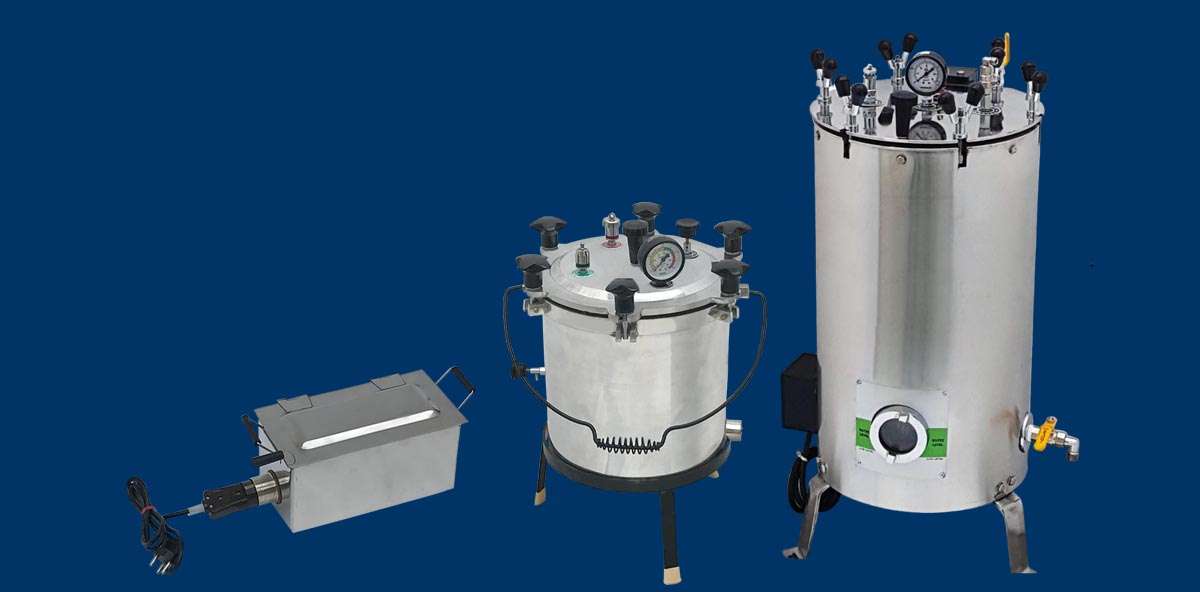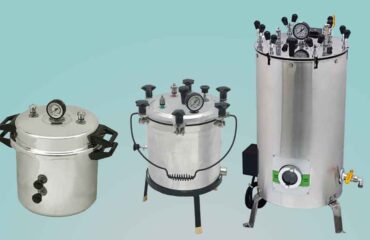An autoclave sterilizer is an essential piece of equipment in any medical facility due to its critical role in ensuring the sterility and safety of medical instruments and supplies.

Here’s why an autoclave sterilizer is important for a medical facility, particularly in India or anywhere else:
Effective Sterilization
- Microorganism Elimination: Autoclaves use high-pressure saturated steam at temperatures of 121-134°C to kill all forms of microbial life, including bacteria, viruses, fungi, and spores. This level of sterilization is crucial for preventing infections.
Compliance with Health Standards
- Regulatory Requirements: Medical facilities must comply with strict health regulations and standards to maintain their licenses. Autoclaves help meet these sterilization standards set by health authorities.
Patient Safety
- Preventing Infections: Proper sterilization of medical instruments reduces the risk of hospital-acquired infections (HAIs). This is crucial for patient safety, recovery, and overall healthcare outcomes.
Operational Efficiency
- Quick Turnaround: Autoclaves are efficient and can quickly sterilize a large number of instruments, ensuring that the medical staff always has sterile equipment ready for use, which is essential in high-demand environments.
Versatility
- Wide Range of Applications: Autoclaves can sterilize a variety of materials including surgical instruments, lab equipment, medical waste, and more, making them versatile for different departments within a hospital.
Cost-Effective
- Durability and Longevity: While the initial investment might be significant, autoclaves are durable and require minimal maintenance, making them cost-effective in the long run. They also reduce the need for disposable instruments, saving costs on supplies.
Environmental Impact
- Reduced Waste: By sterilizing and reusing instruments, autoclaves help in reducing medical waste, which is environmentally beneficial and reduces disposal costs.
Enhanced Workflow
- Streamlined Processes: The consistent and reliable sterilization process of autoclaves helps streamline the workflow in medical facilities, ensuring that sterilization does not become a bottleneck in medical procedures.
Importance in the Indian Context
- Infection Control: India, like many other countries, faces challenges with hospital-acquired infections. Autoclaves play a critical role in controlling and reducing these infections.
- Healthcare Expansion: As India continues to expand its healthcare infrastructure, the need for reliable and effective sterilization methods becomes even more crucial.
- Varied Healthcare Settings: From large urban hospitals to rural clinics, autoclaves are essential across all settings to ensure consistent sterilization standards.
Autoclave sterilizers are vital for maintaining the highest standards of hygiene and safety in medical facilities. They protect patients, comply with health regulations, enhance operational efficiency, and are a cost-effective solution for ensuring that medical instruments are properly sterilized and ready for use.
Main types of Hospital Sterilizers
Hospital sterilizers are essential medical devices used to sterilize surgical instruments, laboratory products, and other medical tools to ensure they are free from any viable microorganisms. This process is crucial for maintaining a sterile environment in medical settings to prevent infections and ensure patient safety. Here are the main types of hospital sterilizers:
Steam Sterilizers (Autoclaves):
- Function: Use high-pressure saturated steam at temperatures of 121-134°C to kill all forms of microorganisms, including spores.
- Common Uses: Sterilizing surgical instruments, medical waste, laboratory equipment, and other heat and moisture-resistant items.
Dry Heat Sterilizers:
- Function: Use hot air that is either static or forced to circulate at high temperatures (160-170°C) to achieve sterilization.
- Common Uses: Sterilizing instruments that may be damaged by moisture, such as powders, oils, and metal instruments.
Chemical Sterilizers:
- Function: Use chemical agents such as ethylene oxide, hydrogen peroxide, or peracetic acid to sterilize medical equipment.
- Common Uses: Ideal for items sensitive to heat and moisture, including electronic medical devices and certain plastic instruments.
Radiation Sterilizers:
- Function: Utilize ionizing radiation, such as gamma rays or electron beams, to destroy microorganisms.
- Common Uses: Often used for single-use medical devices, such as syringes, surgical gloves, and other disposable items.
Plasma Gas Sterilizers:
- Function: Use hydrogen peroxide gas plasma to sterilize at low temperatures.
- Common Uses: Suitable for heat- and moisture-sensitive instruments, including endoscopes and some surgical instruments.
Ultraviolet (UV) Sterilizers:
- Function: Employ UV light to kill or inactivate microorganisms by disrupting their DNA.
- Common Uses: Often used for air and surface disinfection, and in some cases, for sterilizing water and certain medical tools.
Key Considerations for Using Hospital Sterilizers:
- Compatibility: Ensure the items to be sterilized are compatible with the chosen sterilization method to avoid damage.
- Cycle Duration: The duration of sterilization cycles can vary; steam sterilizers typically have shorter cycles compared to chemical sterilizers.
- Safety: Handling of chemical sterilizers requires special safety measures due to the potential toxicity of the chemicals used.
- Validation and Monitoring: Regular testing and validation of sterilizers are necessary to ensure they are functioning correctly and achieving the required sterility levels.
Importance of Sterilizers in Hospitals:
- Infection Control: Proper sterilization is vital to prevent hospital-acquired infections (HAIs).
- Compliance: Hospitals must adhere to stringent regulations and standards for sterilization to ensure patient and staff safety.
- Instrument Longevity: Appropriate sterilization techniques help in maintaining the integrity and longevity of medical instruments.
Role of Hospital Sterilizer in Health Care
Hospital sterilizers play a crucial role in healthcare by ensuring that all medical instruments, devices, and environments are free from harmful microorganisms. This is essential for preventing infections and ensuring patient safety. Here are the key roles and impacts of hospital sterilizers in healthcare:
Infection Prevention and Control
- Elimination of Pathogens: Sterilizers destroy all forms of microbial life, including bacteria, viruses, fungi, and spores, which can cause infections if transferred to patients.
- Reduction of Hospital-Acquired Infections (HAIs): By effectively sterilizing surgical instruments and medical equipment, sterilizers help reduce the incidence of HAIs, which are a major concern in healthcare settings.
Ensuring Patient Safety
- Sterile Surgical Instruments: Sterilizers ensure that surgical instruments are free from contaminants, which is crucial for the success of surgical procedures and the prevention of post-operative infections.
- Sterile Environment: They help maintain a sterile environment in operating rooms, intensive care units, and other critical areas.
Compliance with Regulations and Standards
- Adherence to Guidelines: Hospitals are required to follow stringent guidelines and standards for sterilization set by organizations such as the Centers for Disease Control and Prevention (CDC) and the World Health Organization (WHO).
- Accreditation: Proper sterilization practices are essential for hospital accreditation and certification, which in turn affects the hospital’s reputation and ability to operate.
Maintenance of Equipment Integrity
- Prolonging Equipment Life: Proper sterilization techniques help maintain the integrity and functionality of medical instruments, ensuring they remain effective and safe to use over time.
- Preventing Damage: Different sterilization methods are used based on the material and sensitivity of the instruments to avoid damage during the sterilization process.
Supporting Surgical and Medical Procedures
- Surgical Readiness: Sterilizers ensure that all surgical tools are ready and safe for use, which is critical for the smooth operation of surgical departments.
- Laboratory Safety: They are also used to sterilize laboratory equipment and supplies, ensuring accurate test results and the safety of lab personnel.
- Efficient Resource Use: Proper sterilization protocols maximize the use of medical equipment by reducing the need for frequent replacements due to contamination.
Protecting Healthcare Workers
- Safe Handling: Sterilizers protect healthcare workers by ensuring that instruments and surfaces they handle are free from infectious agents.
- Reducing Occupational Hazards: Effective sterilization practices minimize the risk of occupational exposure to harmful pathogens.
Conclusion
In summary, hospital sterilizers are vital for maintaining a sterile and safe healthcare environment. They play a fundamental role in infection control, patient safety, regulatory compliance, and the efficient operation of healthcare facilities. By ensuring that all medical instruments and environments are properly sterilized, they help prevent infections, protect patients and healthcare workers, and contribute to the overall quality and effectiveness of healthcare services.
